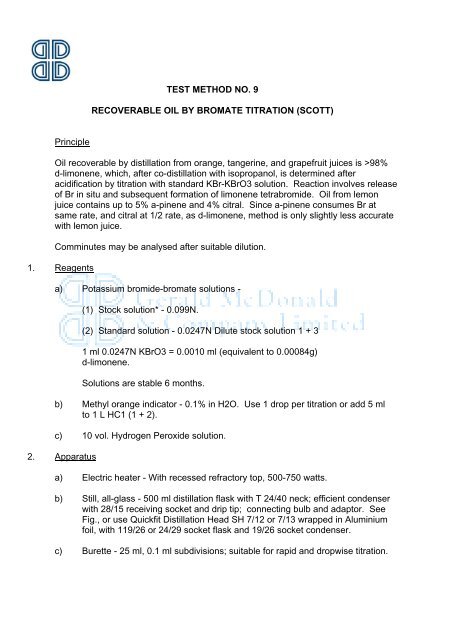Recoverable Oil by Bromate Titration (Scott)
Recoverable Oil by Bromate Titration (Scott)
Recoverable Oil by Bromate Titration (Scott)
Create successful ePaper yourself
Turn your PDF publications into a flip-book with our unique Google optimized e-Paper software.
Principle<br />
TEST METHOD NO. 9<br />
RECOVERABLE OIL BY BROMATE TITRATION (SCOTT)<br />
<strong>Oil</strong> recoverable <strong>by</strong> distillation from orange, tangerine, and grapefruit juices is >98%<br />
d-limonene, which, after co-distillation with isopropanol, is determined after<br />
acidification <strong>by</strong> titration with standard KBr-KBrO3 solution. Reaction involves release<br />
of Br in situ and subsequent formation of limonene tetrabromide. <strong>Oil</strong> from lemon<br />
juice contains up to 5% a-pinene and 4% citral. Since a-pinene consumes Br at<br />
same rate, and citral at 1/2 rate, as d-limonene, method is only slightly less accurate<br />
with lemon juice.<br />
Comminutes may be analysed after suitable dilution.<br />
1. Reagents<br />
a) Potassium bromide-bromate solutions -<br />
(1) Stock solution* - 0.099N.<br />
(2) Standard solution - 0.0247N Dilute stock solution 1 + 3<br />
1 ml 0.0247N KBrO3 = 0.0010 ml (equivalent to 0.00084g)<br />
d-limonene.<br />
Solutions are stable 6 months.<br />
b) Methyl orange indicator - 0.1% in H2O. Use 1 drop per titration or add 5 ml<br />
to 1 L HC1 (1 + 2).<br />
c) 10 vol. Hydrogen Peroxide solution.<br />
2. Apparatus<br />
a) Electric heater - With recessed refractory top, 500-750 watts.<br />
b) Still, all-glass - 500 ml distillation flask with T 24/40 neck; efficient condenser<br />
with 28/15 receiving socket and drip tip; connecting bulb and adaptor. See<br />
Fig., or use Quickfit Distillation Head SH 7/12 or 7/13 wrapped in Aluminium<br />
foil, with 119/26 or 24/29 socket flask and 19/26 socket condenser.<br />
c) Burette - 25 ml, 0.1 ml subdivisions; suitable for rapid and dropwise titration.
3. Determination<br />
Preheat electric heater. Pipette sufficient sample to give a titre of not less than 10<br />
mls nor greater than 25 mls, into distillation flask containing SiC chips or glass<br />
beads, and add 25 ml isopropyl alcohol. If SO2 is present, add 1 drop 10 vol. H2O2.<br />
Distil into 100 ml conical flask and continue distillation until beads of moisture appear<br />
in bend of stillhead. Distillate volume will be approximately 25 ml. Remove flask,<br />
leaving heater on for next determination. Add 10 ml HC1 (1 + 2) and indicator.<br />
Titrate with standard KBr-KBrO3. Major portion of titrant may be added rapidly, but<br />
end point (disappearance of colour) must be approached at ca 1 drop/sec. Let titre =<br />
T1.<br />
Determine reagent blank <strong>by</strong> titrating 3 separate mixtures of 25 ml isopropyl alcohol,<br />
10 ml HC1 (1 + 2), and indicator without refilling the burette. Total ml titration/3 =<br />
average blank T2.<br />
4. Reporting<br />
<strong>Recoverable</strong> <strong>Oil</strong> = (T1 - T2) x 0.1f<br />
------------------- % v/v<br />
Sample size<br />
Where f = factor for KBr - KBrO3 reagent from 0.0247N<br />
eg. when using 0.10N KBr - KBrO3 stock solution f = 1.012<br />
* Use volumetric reagent of 0.1NKBr-BrO3 obtainable from chemical suppliers. If<br />
this is not available, prepare stock solution and standardise as A.O.A.O. Analytical<br />
methods 15 ed. 1990 947.13.<br />
Reference AOAC 15th Ed. 1990 968.20<br />
17 June, 1993<br />
Gerald McDonald & Company Limited<br />
Cranes Farm Road, Basildon, Essex SS14 3GT.Tel: (+44) 01268 244900. Fax: (+44) 01268 244910.<br />
www.geraldmcdonald.com


